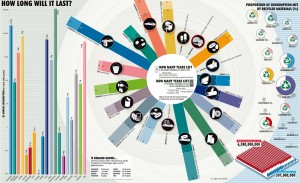Before cash, there was land. The family held some, and grew rice on it. It was passed to the children — the sons anyway. Divided among them. They passed it to their sons in turn, and the soil split into fractals. But the people didn’t get smaller too, and so they began to starve. This process is still going on in places like Ethiopia, Bangladesh, Laos.
Yet we in the industrialized world seem astonished that our parents could afford the houses that we cannot.
The economics of sustenance farming in the face of rising population are immediately clear, yet we do not take the general lesson. We still act like we have infinite resources. Our population is still increasing, yet land, water, oil, and every single mineral is finite and running out. A 2007 article in New Scientist discusses this more cogently than anything I’ve ever seen, including the above chart “How Long Will It Last?”
We need to apply the same thinking to energy. I am not talking about running out of oil. The oil will run out, of course, and not before we do tremendous environmental damage — I, for one, am planning on hitting the world’s great beaches sooner rather than later. But when the oil is gone, it’s simply gone. Unlike copper or plastic, energy cannot be recycled in any way (in fact energy is the limiting input in recycling everything else.) We have no choice but to switch to sunlight for our ongoing power needs. And sunlight, like land, will have to be divided smaller and smaller among more and more of us.
I’m currently looking for an apartment in Hong Kong. On my own I can afford about 200 square feet. I saw a place where the Indonesian nannies live; there were six people in this space, crammed into bunk beds barely narrower than the one tiny room. I was shocked, until I realized that I had arrived in the future. It’s not going to get better. We’re already out of space, but soon we will feel the energy pinch. One day soon, electricity, transport, and hot water are going to be just as rationed as real estate (by each of us individually, because of the cost.)
An engineer named Saul Griffith has done the calculations. To meet the current world population’s current energy requirements, we would need to collect the incident sunlight over an area about the size of Australia. That’s a stupendous amount of solar power to build. It will be a very long time before it is built, if ever. More fundamentally, the physical relationship between incident sunlight and land area brings us right back to passing ever-smaller fields to our children. (By the way, nuclear power won’t help: even without building more power plants we will run out uranium some time in the next century. And wind power, wave power etc. are actually solar driven.)
We will never see the easy material affluence of our parents; we have entered the zero-sum game phase of land- and energy-measured wealth where the only way to get more is to take from someone else (as evidenced by the increasing wealth inequality in industrialized countries over the past few decades.) We can no longer teach our children to expect more than their parents. It’s all a lie; barring insane technological shifts or catastrophic population reduction, the future is high density.
The big house of the American Dream, which is also the big house of the aspiring middle-class everywhere in the world, is over.

